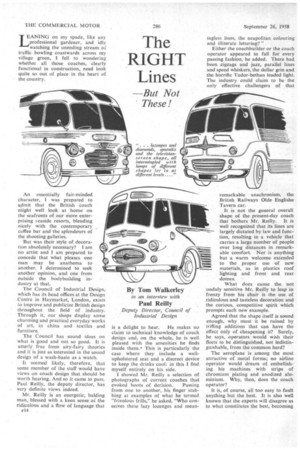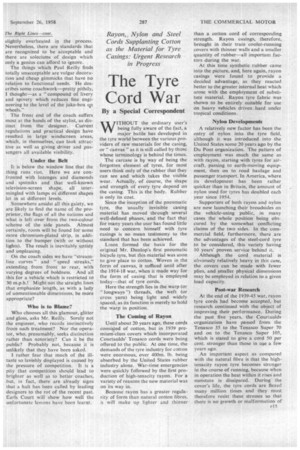The RIGHT Lines
Page 128

Page 129

If you've noticed an error in this article please click here to report it so we can fix it.
—But Not These!
EANING on my spade, like any professional gardener, and idly watching the unending stream of traffic bowling coastwards across my village green, I fell to wondering whether all those coaches, clearly functional in construction, need look quite so out of place in the heart of the country.
An essentially fair-minded character, I was prepared to admit that the British coach might well look at home on the seafronts of our more enterprising Feaside resorts, blending nicely with the contemporary coffee bar and the splendours of the shooting galleries.
But was their style of decoration absolutely necessary? I am no artist and I am prepared to concede that what pleases one man may be anathema to another: I determined to seek another opinion, and one from outside the bodybuilding industry at that.
The Council of Industrial Design, which has its head offices at the Design Centre in Haymarket, London, exists to improve and publicize British design throughout the field of industry. Through it, our shops display some charming and practical everyday works of art, in china and textiles and furniture.
The Council has sound ideas on what is good and not so good. It is utterly free from airy-fairy theories and it is just as interested in the sound design of a wash-basin as a watch.
It seemed likely, therefore, that some member of the staff would have views on coach design that should be worth hearing. And so it came to pass. Paul Reilly, the deputy director, has very definite views indeed.
Mr. Reilly is an energetic, balding man, blessed with a keen sense of the ridiculous and a flow of language that F14 is a delight to hear. He makes no claim to technical knowledge of coach design and, on the whole, heis well pleased with the amenities he finds inside them,' This is particularly the case . where they include a wellupholstered seat and a discreet device to keep the drinks cool: in this I find myself entirely on his side.
I showed Mr. Reilly a selection of photographs of current coaches that evoked hoots of derision. Passing from one to another, his finger stabbing at examples of what he termed "frivolous frills," he asked, "Who conceives these lazy lozenges and mean ingless lines, the neapolitan colouring and illiterate lettering?"
Either the coachbuilder or the coach operator appeared to fall for every passing fashion, he added. There had been zigzags and jazz, parallel lines and speed whiskers, the dollar grin and the horrific Tudor-bethan leaded light. The industry could claim to be the only effective challengers of that remarkable anachronism, the British Railways Olde Englishe Tavern car.
It is not the general overall shape of the present-day coach that bothers Mr. Reilly. It is well recognized that its lines are — largely dictated by law and func tion, resulting in a vehicle that carries a large number of people over long distances in remarkable comfort. Nor is anything but a warm welcome extended to the proper use of new materials, as in plastics roof lighting and front and rear domes.'
What does cause the not unduly sensitive Mr. Reilly to leap in frenzy from his chair is the use of ridiculous and tasteless decoration and the curious, competitive spirit which prompts each new example.
Agreed that the shape itself is sound enough, why must it be ruined by trifling additions that can have the effect only of cheapening it? Surely, he says, operators would wish their fleetsto be distinguished, not indistinguishable, from the common herd?
The aeroplane is among the most attractive of metal forms; no airline operator would dream of embellishing his machines with strips of chromium plating and anodized aluminium. Why, then, does the coach operator?
It is, of course, all too easy to fault anything but the best. It is also well known that the experts will disagree as to What constitutes the best, becoming slightly overheated in the process. Nevertheless, there are standards that are recognized to be acceptable and there are solecisms of design which only a genius can afford to ignore.
The things which Paul Reilly finds totally unacceptable are vulgar decoration and cheap gimmicks that have ho relation to functional needs. He describes some coachwork—pretty pithily, I thought—as a compound of livery and spivery which reduces fine engineering to the level of the juke-box o.n wheels."
The front end of the coach suffers. most at the hands of the stylist, as distinct from the designer. Current regulations and practical design have resulted in large windscreen areas, which, in themselves, can look auraefive as well as giving driver and passengers all available visibility.
Under the Belt
It is below the window line that the thing runs riot. Here we are confronted with lozenges and diamonds and sputniks and that well-known television-screen shape, all intermingled with lamps of different shapes let in at different levels.
Somewhere amidst all this gaiety, we are likely to find the name of the proprietor, the flags of all the nations arid what is left over from the two-colour scheme of the side panels. Almost certainly, room will be found for some more chromium-plated strip, in addition to the bumper (with or without lights). The result is inevitably untidy and unpleasing.
On the coach sides we have "streamline curves" and speed streaks," extending from front to rear, with varying degrees of boldness. And all this for a vehicle which is restricted to 30 m.p.h.? Might not the straight lines that emphasize length, as with a lady of unmentionable dimensions, be more appropriate?
Who is to Blame?
Who chooses all this glamour, glitter and gloss, asks Mr. Reilly. Surely not the engineer, who recoils instinctively from such treatment? Nor the operator, who, presumably, seeks distinction rather than notoriety? Can it be the public? Probably not, because it is unlikely that they have been asked.
1 rather fear that much of the illtaste so lavishly displayed is caused by the pressure of competition. It is a pity that competition should lead to brighter as well as to better coaches, but, in fact, there are already signs that a halt has been called by leading designers to the rot of the recent past. Earls Court will show how well the unfortunate lessons have been learnt.












































































































































































































































































































































